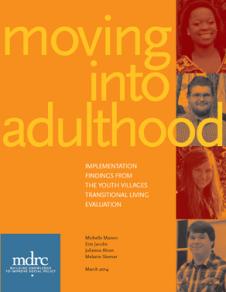Moving into Adulthood
Implementation Findings from the Youth Villages Transitional Living Evaluation

The Youth Villages Transitional Living program is intended to help youth who were formerly in foster care or juvenile justice custody, or who are otherwise unprepared for adult life, to make the transition to independent living. Youth Villages, which serves emotionally and behaviorally troubled young people, operates a number of programs in addition to Transitional Living. All of its programs are based on a set of core principles that emphasize treatment planning, systematic assessment of participating youth, and delivery of only evidence-informed practices within a highly structured supervisory system.
Transitional Living clients receive intensive, individualized, and clinically focused and community-based case management, support, and counseling from staff who carry caseloads of about eight clients each. Youth eligibility is determined through an extensive recruitment and assessment process. Once youth are enrolled, Transitional Living staff continue to assess them to identify needs and work with them to develop goals, which become the basis of required weekly meetings. Over nine months, on average, program participants get support for education, housing, mental or physical health, employment, and life skills. This support is provided in a variety of forms, including action-oriented activities that involve completing a specific task during a weekly session or through more traditional counseling techniques.
The Transitional Living Evaluation is focused exclusively on the program in Tennessee, although Youth Villages also has Transitional Living programs in six other states.
Key Findings
- Variation in the local context across Tennessee shaped the experiences of youth who participated in the evaluation. Resources that can be limited or challenging to navigate, particularly in rural areas, include access to transportation, employers, and social service providers.
- Staff interviews and analysis of the management information system indicated that the Transitional Living program was implemented in accordance with the program model, with the frequency and duration of Transitional Living services close to expected levels.
- Participation levels in the Transitional Living program were high, and youth were engaged in services soon after being assigned to receive them. Staff discussed a wide range of topics with their cases and made contact with other adults who were involved in each youth’s life.
A report presenting the impacts of the program after one year is planned for release in 2015.







